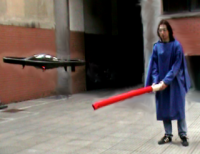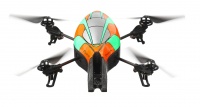Difference between revisions of "Jedi Robot Training 3.0"
| Line 14: | Line 14: | ||
|type=Course | |type=Course | ||
}} | }} | ||
| − | This is a project for the Computer Engineering Lab Course aimed at implementing a system | + | |
| + | Jedi Training is a HI-CoRG (Highly Interactive, Competitive Robogame), a subfield of generic Robogames, characterized by dynamism and competition among users and robots. | ||
| + | |||
| + | This is a project for the Computer Engineering Lab Course (ord. 270 - 5cfu) aimed at implementing a system that recreates the Luke Skywalker's training as a Jedi Knight: a quadricopter (drone) flies around the Player (Luke), who wears a special game uniform and wields a light-saber, and shoot him with laser blasts. The Player must parry those blasts with his light-saber. | ||
This work is done as part of the [[Highly Interactive Robogames]] effort in the [[Jedi Training Robogame]] line, and extends the results obtained by other projects in the direction of better drone, better behavior, and better playability. | This work is done as part of the [[Highly Interactive Robogames]] effort in the [[Jedi Training Robogame]] line, and extends the results obtained by other projects in the direction of better drone, better behavior, and better playability. | ||
| Line 20: | Line 23: | ||
The main revolution in comparison to the previous versions is the drone itself. It is no more a mechanical arm attached to a table, but a real flying quadricopter ([http://ardrone.parrot.com A.R.Parrot Drone]) | The main revolution in comparison to the previous versions is the drone itself. It is no more a mechanical arm attached to a table, but a real flying quadricopter ([http://ardrone.parrot.com A.R.Parrot Drone]) | ||
| − | The project relies on both the official SDK | + | The project relies on both the official SDK and the openCV 2.1 libraries for image processing. |
| − | Diego Martinoia developed the high-level intelligence and image processing, while Daniele Calandriello dealt with | + | Diego Martinoia developed the high-level intelligence and image processing, while Daniele Calandriello dealt with low-level implementation and interfacing. |
The player is supposed to wear a uniform with the double purpose of being identified and "feel" the game. The sword used is a red swimming noodle, since the real-glowing light-blue wii-lightsaber accessory produced a too high intensity light that disturbed the recognition of the uniform color. | The player is supposed to wear a uniform with the double purpose of being identified and "feel" the game. The sword used is a red swimming noodle, since the real-glowing light-blue wii-lightsaber accessory produced a too high intensity light that disturbed the recognition of the uniform color. | ||
The game is very dynamic, being the player able to move freely in the space, and the drone follows him/her, while keeping the interaction on. | The game is very dynamic, being the player able to move freely in the space, and the drone follows him/her, while keeping the interaction on. | ||
| + | |||
| + | Further expansion might be addressed towards a more active interaction with the environment and the possibility for the player to move even on the z axis, so far prevented for safety reasons. | ||
-- More info in the Discussion area (for AIRWiki users only) -- | -- More info in the Discussion area (for AIRWiki users only) -- | ||
Revision as of 08:05, 28 June 2011
Jedi Robot Training 3.0
| |
| Short Description: | An highly competitive robotic game, which is inspired by George Lucas' Star Wars Saga. |
| Coordinator: | AndreaBonarini (andrea.bonarini@polimi.it) |
| Tutor: | AndreaBonarini (andrea.bonarini@polimi.it) |
| Collaborator: | |
| Students: | DiegoMartinoia (diego.martinoia@mail.polimi.it), DanieleCalandriello () |
| Research Area: | Robotics |
| Research Topic: | Robogames |
| Start: | 2010/10/07 |
| End: | 2011/03/30 |
| Status: | Closed |
| Level: | Bs |
| Type: | Course |
Jedi Training is a HI-CoRG (Highly Interactive, Competitive Robogame), a subfield of generic Robogames, characterized by dynamism and competition among users and robots.
This is a project for the Computer Engineering Lab Course (ord. 270 - 5cfu) aimed at implementing a system that recreates the Luke Skywalker's training as a Jedi Knight: a quadricopter (drone) flies around the Player (Luke), who wears a special game uniform and wields a light-saber, and shoot him with laser blasts. The Player must parry those blasts with his light-saber.
This work is done as part of the Highly Interactive Robogames effort in the Jedi Training Robogame line, and extends the results obtained by other projects in the direction of better drone, better behavior, and better playability.
The main revolution in comparison to the previous versions is the drone itself. It is no more a mechanical arm attached to a table, but a real flying quadricopter (A.R.Parrot Drone)
The project relies on both the official SDK and the openCV 2.1 libraries for image processing.
Diego Martinoia developed the high-level intelligence and image processing, while Daniele Calandriello dealt with low-level implementation and interfacing.
The player is supposed to wear a uniform with the double purpose of being identified and "feel" the game. The sword used is a red swimming noodle, since the real-glowing light-blue wii-lightsaber accessory produced a too high intensity light that disturbed the recognition of the uniform color.
The game is very dynamic, being the player able to move freely in the space, and the drone follows him/her, while keeping the interaction on.
Further expansion might be addressed towards a more active interaction with the environment and the possibility for the player to move even on the z axis, so far prevented for safety reasons.
-- More info in the Discussion area (for AIRWiki users only) --
A test of the developed system. Notice that it is working outside, with confusing colors in background. The system is quite robust, and very playable. It has been tested also in public exhibitions like the 2011 Open day at Politecnico di Milano.

